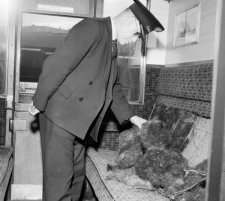|
Home
Whale uses
Baleen
Fashion
Utilitarian
|
Utilitarian
uses
Whale-bone
prices were always a reflection of the demand for whale-bone for
fashion uses. If the use declined then so did the profit margin
of the whalers.
The
revolutionary movement that shook France between 1787 and 1799 and
the Napoleonic wars that followed were a major disruption for the
fashion business. During the "Terror" to wear anything
remotely aristocratic in style was to invite an appointment with
Madame Guillotine and as a result the corset trade collapsed, and
with it the price of whale-bone, from £398 a ton in 1766-69
to £102 in 1795.
An
immediate result of the fall in price of whale-bone was a rapid
development of less fashionable uses. The lightness, strength, elasticity
and flexibility that had made whale-bone so useful to stay-makers
and corsetieres meant that it was valuable in many other areas.
For
example, whale-bone spokes dominated the umbrella market until 1852,
when one Samuel Fox of Sheffield patented umbrella steel.
The
thicker parts of the whale-bone plates were used for knife handles,
carriage springs, bed-springs, fishing rods and carriage whips.
The
thinner and lighter parts were used as frames for military headgear
including guardsmen's busbies and bearskins.
In
1808, Samuel Crackles of Hull patented a method of cutting plates
of whale-bone to provide an effective substitute for brush bristles.
These hard wearing bristles were in much demand, particularly for
chimney-sweeps' brushes.
Another
Hull company, John Bateman and Robert Bowman of Silver Street, were
also trading in whale-bone at that time, offering a wide range of
small goods including sieves, nets, ornamental blinds, bed-bottoms
and brushes.
Nothing
was wasted: waste shavings from the manufacture of other products
and the hairy bristles from the edges of the plates were used to
upholster furniture and seating on railway carriages.
Whale-bone
could also be moulded, under heat and pressure, into complex shapes
and was used for a variety of luxury items. These included the handles
of toddy and punch ladles, twisted walking sticks, the handles of
Samurai swords, and hair combs.
Whale-bone
was even considered for the production of flying-machines! In 1810,
Thomas Walker published A Treatise Upon the Art of Flying by
Mechanical Means, and wrote:
I
think that the shafts of the wings and tail would answer the purpose
in the best manner, if they were each of them made of six long
strips of whalebone ...
|

İSCRAN/Bridgeman Art Library
Old Dominie, John Burr 1831-93

İSCRAN/National Museums of Scotland
Officer's cap, c. 1692

İSCRAN/Scottish Media Group
New Lanark, Victorian Day, 1980s

İSCRAN/Scotsman Publications
Train - Hibs special, Mr Webster examines torn upholstery, 1959

İSCRAN/Aberdeen City Council
Toddy ladle of whalebone & silver. William Jamieson, c. 1810
|